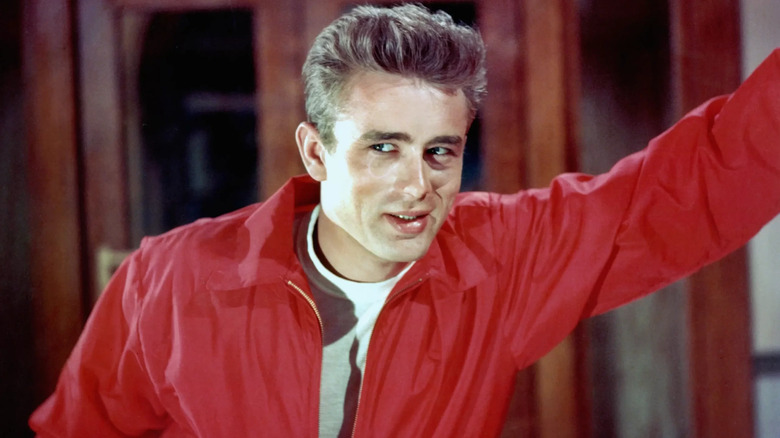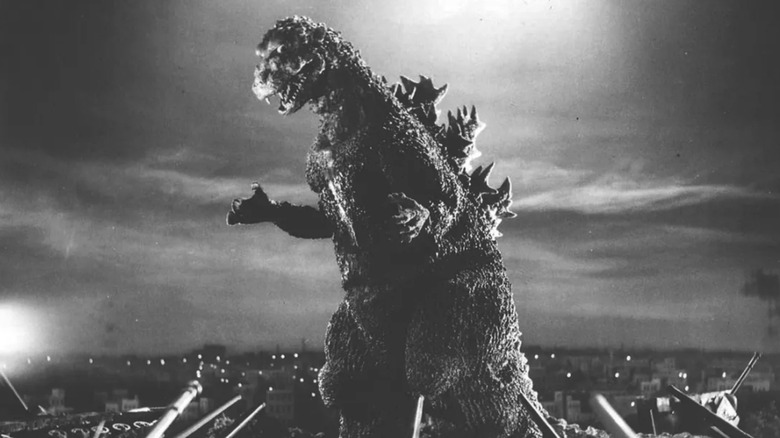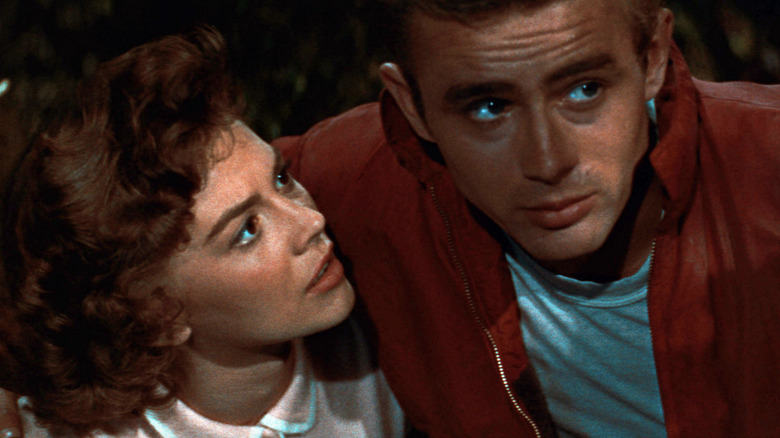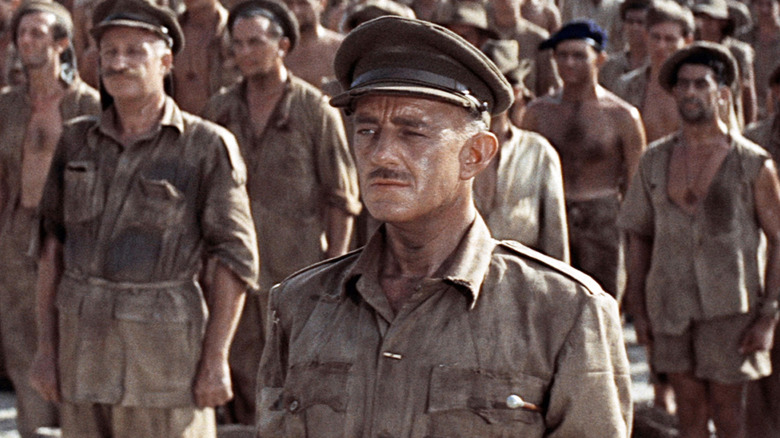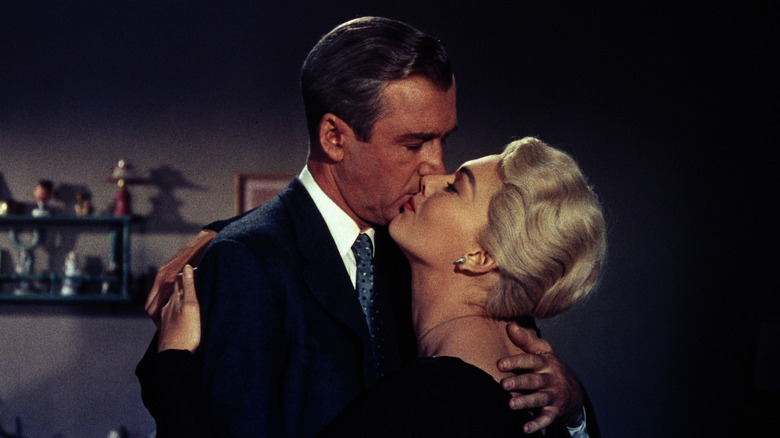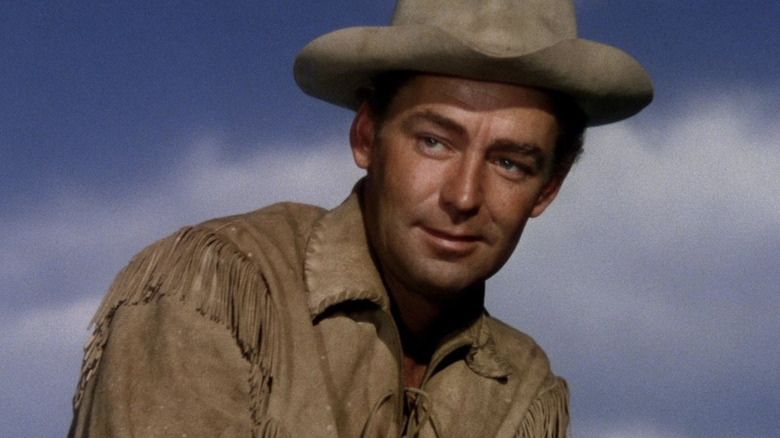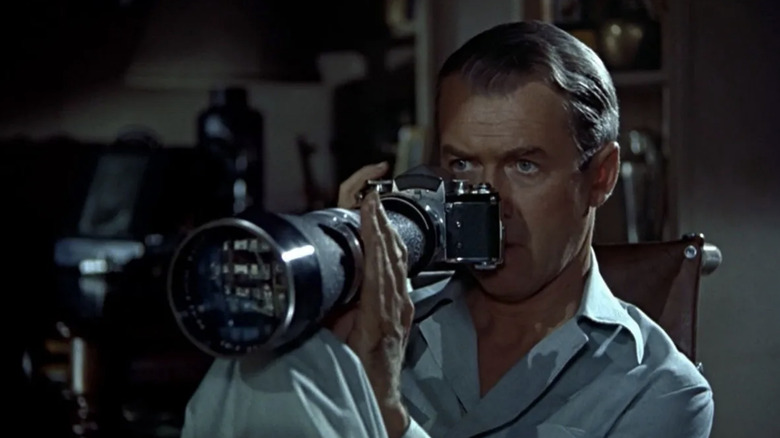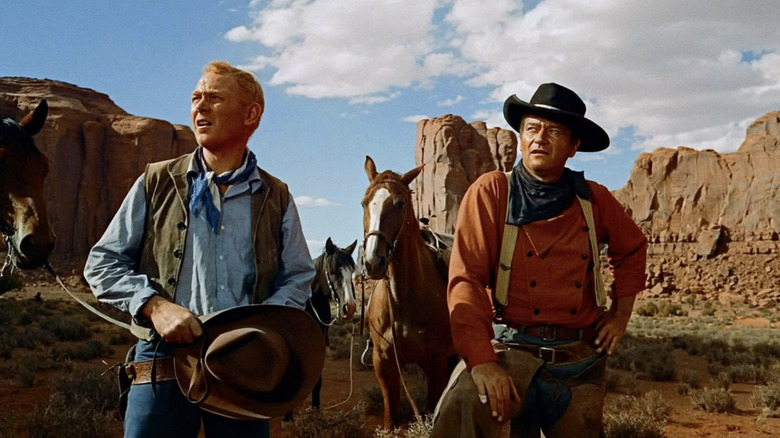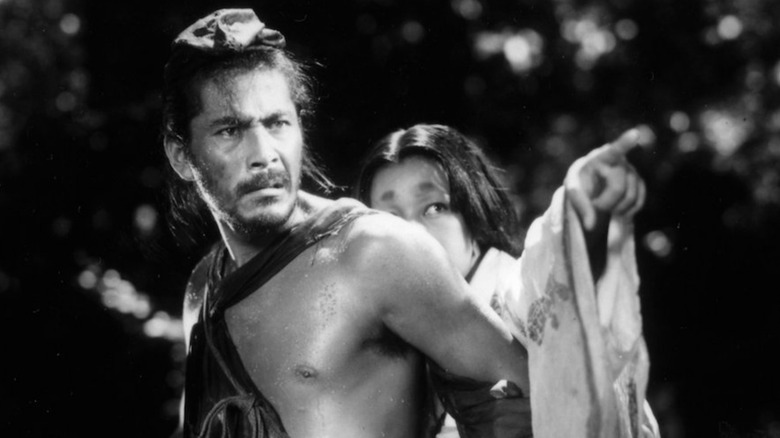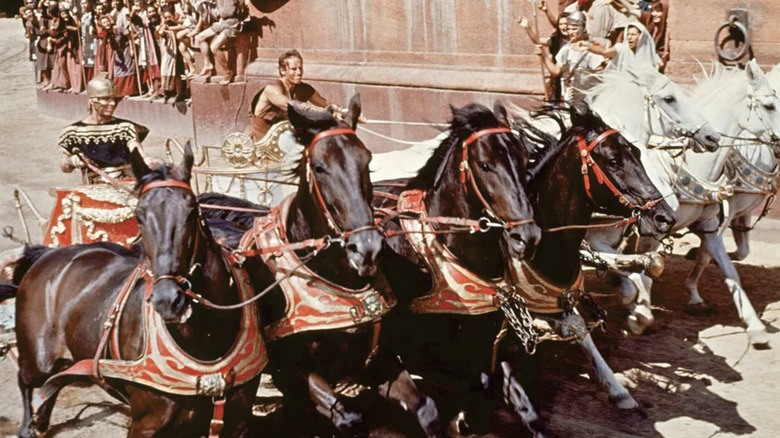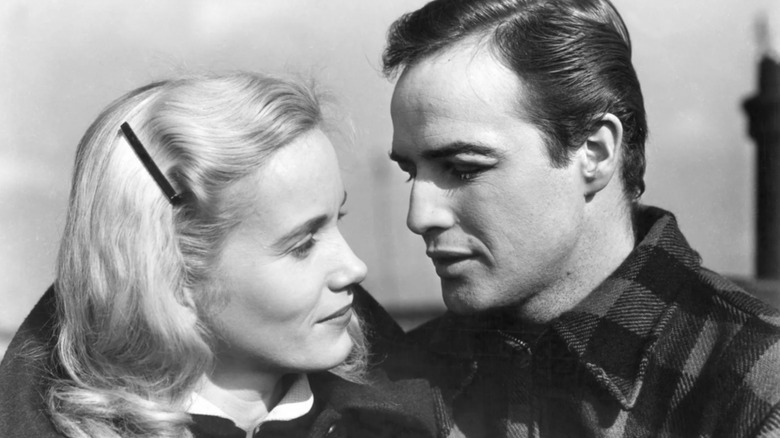The 10 Best Movies Of The 1950s, Ranked
Often considered the beginning of the end for the Golden Age of Hollywood (which had some wild stories of its own), the 1950s were home to a plethora of fantastic films that post-war audiences cherished. Though perhaps far removed from our modern standards of filmmaking, the '50s was a vital decade in moviemaking, one that gave us theatrical classics that we still relish today. Everything from your grandparent's favorite John Wayne flick to some of Alfred Hitchcock's finest hours first hit theaters in this decade. While the Hays Code was still in effect, certain filmmakers challenged the moral restraints that were put on them at the time, leading into the New Hollywood Era the following decade.
Though it would be impossible to fit every cinematic triumph of the 1950s on this list, we've managed to cram some of the best the decade has to offer here — and not every entry is an American picture! If you feel more at home watching Jimmy Stewart, Marlon Brando, John Wayne, and James Dean than some of the modern stars out there, then these are the movies for you.
Godzilla (1954)
The first non-American feature to make it on our list is "Godzilla." Known sometimes as "Gojira" in its native Japan, this is a monster movie of epic proportions. Meant as a kaiju stand-in for Japan's postwar nuclear fears, director Ishirō Honda and Toho launched the Godzilla brand with this black-and-white classic that wowed audiences. But between the impressive miniatures, the groundbreaking special effects, and the eerie warning about the potential dangers of nuclear weapons, "Godzilla" is arguably one of the most important films in Japanese cinema.
"A far cry from its B-movie successors," Tim Martin of The Daily Telegraph wrote of the film, "It was a sober allegory of a film with ambitions as large as its thrice-normal budget, designed to shock and horrify an adult audience." Even if the sequels were a bit uneven, the original "Godzilla's" ability to launch what's considered the longest running feature film franchise makes it stand out. In fact, Japan's "Gojira" was so popular that a re-edited Americanized version — "Godzilla, King of the Monsters!" — was released only two years later, getting the monster across the Pacific, since becoming a global phenomenon.
Rebel Without a Cause (1955)
Already a notable star because of his previous 1955 film, "East of Eden," James Dean blew audiences away once again with his second feature, "Rebel Without a Cause." One of the first major Hollywood pictures to tackle the real-life struggles of the American teenager, this flick was released not long after Dean's death in a fatal car accident. It remains a powerful film that plays as a social commentary on not just teen violence and emotional instability, but also the role that one's home life has in them. Jim Stark (Dean) counters the typical '50s suburban teenager, painting juvenile delinquency as a social disease that can be contracted from any socio-economic status.
Dean is on fire here as a powerful star who commands your attention every moment he's on screen. It's no wonder that his bust is on display at the Griffith Observatory to this day, a location that has become synonymous with the film (sorry, "La La Land"). The chemistry between Dean and Natalie Wood is off the charts, and it's easy to see why Wood went on to be a notable star herself. One of the most important "coming-of-age" films out there, "Rebel Without a Cause" went on to make quite the mark on Hollywood — and the rest of America, too.
The Bridge on River Kwai (1957)
Based on the novel of the same name by Pierre Boulle, "The Bridge on the River Kwai" is a British motion picture directed by David Lean that came to be known as one of the greatest war films ever made. Set in the Pacific Theatre during World War II, the film follows a British regiment of soldiers, led by Alec Guinness' Colonel Nicholson, who have been sent to a POW camp in Thailand after being captured by the Japanese. Tasked with building a bridge (yes, over the River Kwai), the British troops struggle through their captivity, giving audiences not grand battle sequences like most WWII features, but a complex character drama set during one of the harshest times in recent history.
But the real reason "The Bridge on the River Kwai" stands out is because of Alec Guinness' powerful performance as the determined Colonel Nicholson, predating his more famous role in the original "Star Wars" by two decades. In many respects, the film is about a man who loses clear sight of the bigger picture while working to maintain his honor, challenging every notion of what honor truly means in wartime. Over the years, it has earned a vaunted position in the history of World War II films.
Vertigo (1958)
It's hard to look back on the '50s and not note Hitchcock's genius. Having been considered "the greatest film of all time" by the British Film Institute's Sight & Sound Magazine in 2012 (usurping even "Citizen Kane"), "Vertigo" is a true masterclass in the thriller genre. Following retired cop John "Scottie" Ferguson (James Stewart) as he battles a bout of acrophobia (complete with, you guessed it, vertigo), he's tasked with following Madeleine Elster (Kim Novak) on behalf of her husband, an old collegue of Scottie's. Incidentally, he begins to fall for her, only to uncover a mystery so mind-bending you'd almost think you were watching a Hitchcock picture ...
Of course, "Vertigo" is a Hitchcock film, and one of his absolute best. We won't give away the big twist here, but you have to see it to believe it. Aside from a rock-solid plot, "Vertigo" was also a revolutionary piece of filmmaking in its use of distorted perspective via the dolly zoom, which conveys Scottie's vertigo while on the job. As usual, Jimmy Stewart is exceptional here, playing the part the only way that he can — with pure conviction — and though "Vertigo" failed to claim any Academy Awards, it was one of the first 25 films to ever be added to the United States' National Film Registry in 1989.
Shane (1953)
Westerns were quite the rage in the post-war era as audiences reflected on so-called simpler times. Not that the Old West was actually simpler, mind you, but the romanticization of it certainly felt that way. Considered the quintessential Western, "Shane" is a classic horse opera in every sense. As the titular wandering gunfighter, played by Alan Ladd, makes his way into a small ranching community, he finds himself caught between the ranchers and an encroaching cattle baron who threatens their livelihood. It may sound like just your average Western, but this flick made a massive impact on the genre going forward.
Between the breathtaking cinematography (which captures the full scope of Wyoming's magnificent Grand Tetons) and the excellent performances by Ladd and Van Heflin in particular, "Shane" is one of the finest motion pictures of the 1950s. So much so that it's still revisited in Hollywood today — it influenced the James Mangold film "Logan," which includes scenes from the film as well as key lines of dialogue. No wonder Woody Allen once called it "a great movie [that] can hold its own with any film, whether it's a Western or not" (via The New York Times). It really is that good.
Rear Window (1954)
The second Alfred Hitchcock film on this list, and another starring the uber-talented James Stewart, "Rear Window" is a masterpiece of its own. Earning itself four Academy Awards, this 1954 thriller pushed audiences into an uncomfortable position as wheelchair-bound Jeff Jefferies (Stewart) begins to spy on his neighbors. It's all innocent fun at first, something to pass the time, until Jefferies believes he's witnessed a murder. As he begins to uncover this apparent homocide plot, Jefferies is thrown into a whirlwind of obsession, one that threatens his life and the lives of those closest to him.
While Hitchcock and Stewart are at their absolute best here, Grace Kelly is just as wonderful on the screen. As Jefferies' girlfriend Lisa, she puts herself in harm's way to help uncover the mystery behind the neighboring apartment (and the woman believed to have been murdered there), with Hitchcock creating riveting suspense that'll quicken your heartbeat. If you've missed "Rear Window" before now, let this be the sign that convinces you to watch this four-time Oscar nominated thriller — it's an exceptional piece of work.
The Searchers (1956)
Could we really have a Top 10 of the 1950s without John Wayne? The Duke made plenty of great films in this decade (such as "Rio Bravo"), but his best is by far "The Searchers." Directed by John Ford and co-starring Jeffrey Hunter, "The Searchers" follows Civil War veteran Ethan Edwards (Wayne) as he tracks down his missing niece Debbie (Natalie Wood), who has been abducted by a group of Comanche Indians. Filmed in Ford's most beloved shooting location, Monument Valley, the picture makes us feel the vast hopelessness of Edwards' quest. But Wayne's character perseveres, even if his attitude toward the Comanche is rigid and unabashedly tinged with racism.
As far as John Wayne and John Ford collaborations are concerned, there isn't one better. "The Searchers" is generally considered the greatest Western ever made (indeed, one of the greatest of all time), and for good reason. The film's striking scenery, impeccable direction, and Wayne's outstanding performance make it unbeatable. It's messy, violent, and morally complicated, but it's a motion picture that has stuck with us for the better part of a century. And, like a few others on this list, it was one of the first films ever added to the U.S. National Film Registry as a result.
Rashomon (1950)
While "Godzilla" might be the most recognizable of the two Japanese productions on this list, "Rashomon" is by far among the most influential. Directed by celebrated filmmaker Akira Kurosawa — who would go on to make "Seven Samurai" a few years later — "Rashomon" is a compelling tale of diverging perspectives. The same events, a shocking assault of a woman (Machiko Kyō) and the murder of a samurai (Masayuki Mori) involving a bandit named Tajōmaru (Toshiro Mifune), are told from different points of view, each of which make the testifiers look better or worse than before. It's wonderful to watch as some of these actors, especially Mifune, play starkly different versions of their characters throughout the film.
This storytelling technique would influence a surprising host of productions (later dubbed the "Rashomon Effect"), but it was done to perfection here. Unsurprisingly, the 1950 Japanese picture garnered international acclaim, receiving an honorary Oscar for its significance before the Academy Awards had an official international film category. Kurosawa's impeccable direction mixed with the inspired use of dappled light, experimental cinematography, and a tight script make "Rashomon" a delight to watch, whether it's your first time or 10th.
Ben-Hur (1959)
A remake of a silent 1925 film titled "Ben-Hur: A Tale of the Christ" (which itself was based on a Lew Wallace novel), the 1959 version of "Ben-Hur" is an incredible biblical epic that puts all others to shame. Starring Charlton Heston as the titular Judah Ben-Hur, the film tells the story of a Jewish prince living in first-century Judea under the rule of the Roman Empire. During this time, he comes into contact with Jesus Christ (Claude Heater) while pursuing his own course of revenge on the occupying Romans. Of course, the film is best known for its spellbinding (and nearly 10-minute-long) chariot race sequence that'll captivate you instantly.
Aside from the spectacular plot, the grand scale of "Ben-Hur" alone makes it worth the watch. With an incredible attention to detail regarding costuming and set pieces, it feels as if one has traveled back in time to a different era. "Ben-Hur" received its fair share of Academy Awards during its time (winning 11 of them), and has since been celebrated as a cinematic triumph. Clocking in at three and a half hours long, "Ben-Hur" might seem daunting, but it's a beautiful motion picture that highlights the very best of studio filmmaking and makes us yearn for the age of biblical cinematic epics.
On the Waterfront (1954)
Nominated for 12 different Oscars and walking away with eight of them, "On the Waterfront" is arguably the greatest motion picture of the 1950s. A fantastic crime drama that highlights the struggles of working-class Americans, the film was directed by filmmaker Elia Kazan, who maintains his clear and crisp style here. Marlon Brando plays prize fighter and dockworker Terry Malloy as he finds himself mixed up with the wrong crowd, struggling to get out from under the thumb of Johnny Friendly (Lee J. Cobb), a mob boss who is anything but friendly. The film minces no words regarding New Jersey-based organized crime, and heavily promotes the unionization of the dockworkers similarly caught under Friendly's control.
Brando is firecracker here, and it's no wonder that he won an Academy Award for his work on the picture. "On the Waterfront" solidified Brando as one of Hollywood's most notable stars long before "The Godfather," pushing his talents to their on-screen limit. Sure, he had already done "A Streetcar Named Desire" (also with Kazan) and "Julius Caesar," but his work as the conflicted and persistent Terry Malloy is something equally impressive. As another one of the first 25 films to be added to the United States' National Film Registry, "On the Waterfront" is a classic you cannot miss.
